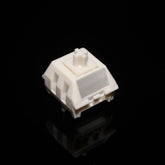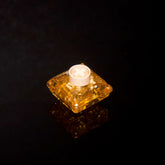how to choose the mechanical switch?
Choosing the right mechanical switch for your keyboard is a critical step in building or buying a mechanical keyboard. Switches significantly affect the typing feel and sound of the keyboard. Here’s a guide to help you choose the mechanical switch that best suits your needs:
Factors to Consider
1. Switch Type
Mechanical switches generally fall into three main categories:
Linear Switches: These have a smooth keystroke with no tactile bump or audible click. Ideal for fast typists and gamers.
Examples: kailh cardamom keyboard switch,Kailh Platycodon Grandiflorum Keyboard Switch
Tactile Switches: These feature a noticeable bump at the actuation point, providing tactile feedback.
Examples: Kailh Box Winter Switch
Clicky Switches: These provide both a tactile bump and an audible click at the actuation point.
Examples: Kailh Box Summer,Kailh Box Autumn Switch
2. Actuation Force
The force required to press a key and register a keystroke varies among switches. It’s measured in grams (g).
Light: ~35g to 45g (e.g., Cherry MX Red)
Medium: ~50g to 60g (e.g., Cherry MX Brown)
Heavy: 70g and above (e.g., Cherry MX Green)
3. Noise Level
Consider the environment where you’ll use the keyboard. If you need a quieter keyboard:
Opt for silent switches Kailh HUSH Deep Sea Switch Pro
Avoid clicky switches if noise is a concern.
4. Durability
Most mechanical switches are rated for a certain number of key presses (e.g., 50 million). Higher durability can mean a longer lifespan.
5. Application
Your primary use case can influence your switch choice:
Gaming: Linear switches are often preferred for their smooth and fast actuation.
Typing: Tactile switches provide feedback, which can be beneficial for typing.
Office Work: Silent or tactile switches are generally preferred to minimize noise.
6. Feel and Preference
Ultimately, personal preference plays a significant role. If possible, try out different switches in person or buy a switch tester to feel the differences.
Choosing the right mechanical switch involves understanding your preferences and needs. Here's a quick checklist to guide you:
Determine Your Primary Use: Gaming, typing, or office work.
Select Switch Type: Linear, tactile, or clicky.
Consider Actuation Force: Light, medium, or heavy.
Evaluate Noise Level: Silent, quiet, or clicky.
Comparison Table
| Feature | Kailh Box Winter (Tactile) | Kailh Box Summer (Clicky) | Kailh Spring (Linear) | Whale Switch (Tactile) |
|---|---|---|---|---|
| Type | Tactile | Clicky | Linear | Tactile |
| Operating Force | 40g | 50g | 50gf | 45 + 10gf |
| Actuation Travel | 2.0+0.4mm | 1.8+0.4MM | 1.8+0.4MM | 2.0 + 0.4mm |
| Tactile Force | 52GF+5GF | 55+10GF | 55+10GF | 60 + 10gf |
| Total Travel | 3.6+0.3mm | 3.6+0.3mm | 3.6+0.3mm | 3.60 + 0.4mm |
| Tactile Bump | Slight | Obvious | None | Noticeable |
| Sound | Quiet | Clicky | Low noise | Quiet |
| Resistance | Dust and water-resistant | Dust and water-resistant | Dust and water-resistant | Dust and water-resistant |
| Ideal Use | Typing and gaming | Typing | Gaming | Typing and gaming |
| Noise Level | Low | High | Low | Low |
| Feedback | Clear tactile feedback | Strong tactile and auditory feedback | Smooth and consistent actuation | Clear tactile feedback |
| User Suitability | Suitable for quiet environments and long-term use | Suitable for those who enjoy strong feedback but not for quiet environments | Suitable for fast key presses and long-term use without fatigue | Suitable for accurate typing and gaming, comfortable for long-term use |










































